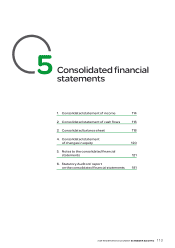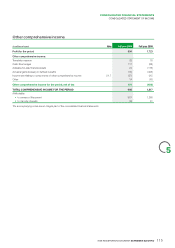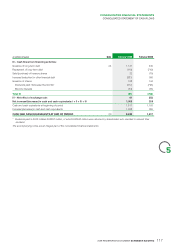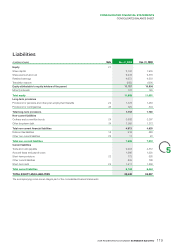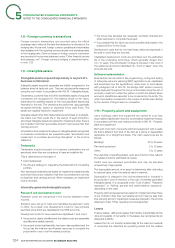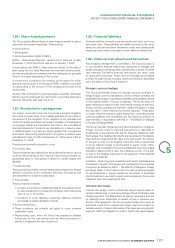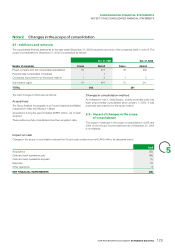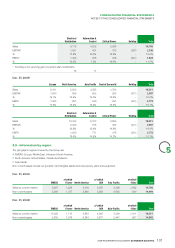APC 2009 Annual Report Download - page 125
Download and view the complete annual report
Please find page 125 of the 2009 APC annual report below. You can navigate through the pages in the report by either clicking on the pages listed below, or by using the keyword search tool below to find specific information within the annual report.
2009 REGISTRATION DOCUMENT SCHNEIDER ELECTRIC 123
CONSOLIDATED FINANCIAL STATEMENTS
5
NOTES TO THE CONSOLIDATED FINANCIAL STATEMENTS
expense, the Group has decided to present the interest component
of these costs and the expected return on plan assets in fi nance
costs and other financial income and expense, net as from
January1, 2009. As a result of this change, EUR 19million recorded
under operating profi t in 2008 and EUR 56million in 2009 have
been reclassifi ed under other fi nance costs and fi nancial income
and expense, net. The comparative fi nancial statements refl ect this
impact.
1.3 - Basis of presentation
The fi nancial statements have been prepared on a historical cost
basis, with the exception of derivatives and available-for-sale
fi nancial assets, which are measured at fair value. Financial liabilities
are measured using the cost model. The carrying amount of
hedged assets and liabilities and the related hedging instruments
corresponds to their fair value.
1.4 - Use of estimates
The preparation of financial statements requires Group and
subsidiary management to make estimates and assumptions that
are refl ected in the reported amounts of assets and liabilities at the
date of the fi nancial statements, revenues and expenses for the
reporting period and related disclosures. Actual results could differ
from those estimates.
These estimates mainly concern:
•the recoverable amount of goodwill, property, plant and
equipment and intangible assets (described in note1.10);
•the net realizable value of inventories and work in process
(described in note1.13);
•the recoverable amount of accounts receivable (described in
note1.14);
•the valuation of share-based payments (described in note1.20);
•the calculation of provisions for contingencies, in particular for
warranties (described in note1.21);
•pension and other post-employment benefi t obligations
(described in note1.19).
1.5 - Consolidation principles
Companies over which the Group exercises exclusive control,
either directly or indirectly, are fully consolidated. Exclusive control is
control by all means, including ownership of a majority voting interest,
signifi cant minority ownership, and contracts or agreements with
other shareholders.
As of January 1, 2009, investments in operating entities controlled
jointly with a limited number of partners, such as joint ventures and
alliances, are proportionally consolidated in accordance with the
recommended treatment under IAS31 - Interests in Joint Ventures.
These investments were previously accounted for by the equity
method.
Companies over which the Group has significant influence
(“associates”) are accounted for by the equity method. Signifi cant
infl uence is presumed to exist when more than 20% of outstanding
voting rights are held.
Companies acquired or sold during the year are included in or
removed from the consolidated fi nancial statements as of the date
when effective control is acquired or relinquished.
Intragroup balances and transactions are eliminated in consolidation.
The list of consolidated subsidiaries and associates is provided in
note32 .
The reporting date for all companies included in the scope of
consolidation is December 31, with the exception of certain
associates accounted for by the equity method, for which fi nancial
statements up to September 30 have been used due to the time
required for them to produce IFRS-compliant statements.
1.6 - Business combinations
Business combinations are accounted for using the purchase
method, in accordance with IFRS3 - Business Combinations. In
accordance with the option provided by IFRS1 – First-Time Adoption
of IFRS – business combinations recorded before January 1, 2004
have not been restated. In accordance with the IFRS3 standard
applicable at year-end, acquisition costs incurred in 2009 related to
transactions which are highly likely to be fi nalised in 2010 have been
capitalised for EUR 25million as of December 31, 2009.
All identifi ed acquired assets, liabilities and contingent liabilities are
recognised at their fair value as of the date of acquisition. Provisional
fair values are adjusted within a maximum of twelve months following
the date of acquisition.
If the cost of acquisition is higher than the fair value of assets
acquired and liabilities assumed at the date of acquisition, the excess
is recorded under goodwill. If the cost of acquisition is lower than
the fair value of assets acquired and liabilities assumed at the date
of acquisition, the negative goodwill is immediately recognised in the
income statement.
Goodwill is not amortised , but tested for impairment at least annually
and when there is an indication that it may be impaired (see note1.11
below). Any impairment losses are recognised under “amortisation
and impairment of purchase accounting intangibles”.
1.7 - Translation of the financial statements
offoreign subsidiaries
The consolidated fi nancial statements are drawn up in euros.
The fi nancial statements of subsidiaries that use another functional
currency are translated into euros as follows:
•assets and liabilities are translated at offi cial year-end exchange
rates;
•income statement and cash fl ow items are translated at weighted-
average annual exchange rates.
Differences arising on translation are recorded in equity under
“Translation reserve”. In accordance with IFRS1 – First Time
Adoption of IFRS – cumulative translation adjustments were reset
to zero at January 1, 2004 by adjusting opening retained earnings,
without any impact on total equity.


